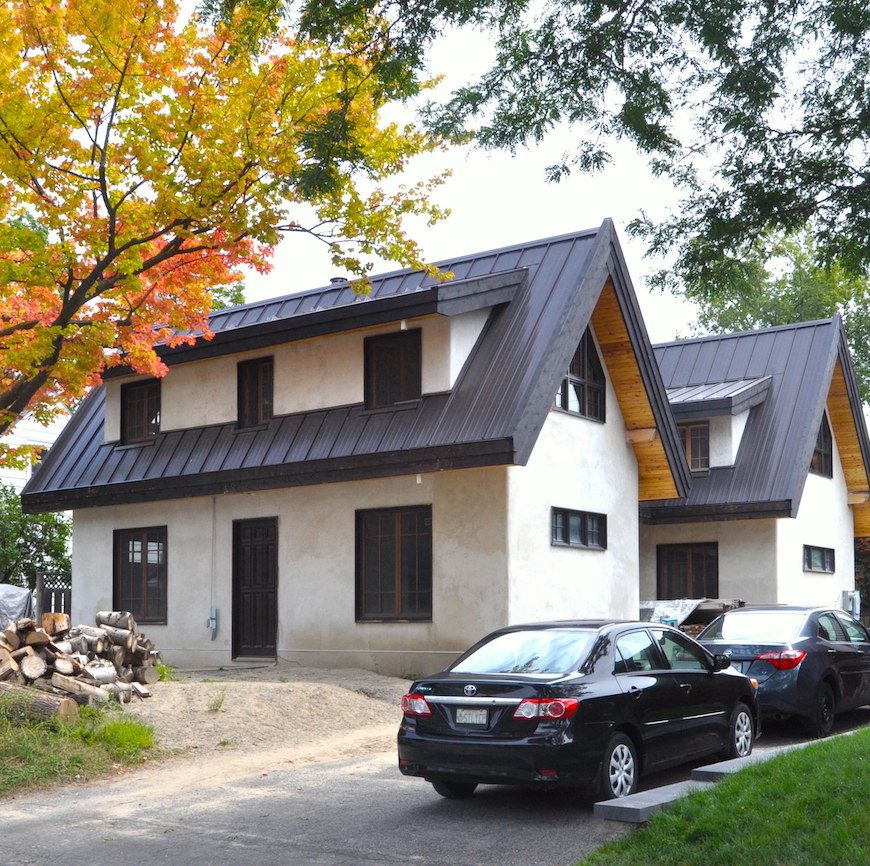
Photography : Alaura Soares unless otherwise indicated
His family lives in the first clay and straw pre-fab house built in Canada. He unplugged the mandatory heat recovery ventilator required for all new homes because his house allows him to access true fresh air through the windows year round without creating discomfort. Its secret: clay. The walls are a fine balance of insulation and mass (straw and clay) and the floors are full mass, both primarily heated by the infrared radiation from the sun and a soapstone masonry heater. "Our industry is far too focused on insulation and energy efficiency, when water conservation, airtightness, thermal mass, and locally sourced, unadulterated, natural materials far outweigh the environmental impact of a building and the purity of the indoor air quality, comfort, and overall health of the occupants living inside," says architect Bobby Ilg. “Water is my main environmental focus these days. We can live without energy, but we simply cannot survive without fresh, clean water. 50% of the water used inside our home comes from the rainwater collected on the roof, which collects approximately 100,000 litres of rainwater a year. The natural properties of clay and its love of water helps naturally control indoor humidity levels, and is one of the simplest ways to prevent building moisture issues such as mould and decay.” Building related illnesses have also become an important component of their natural building philosophy. “With almost 1 in 30 Canadians suffering from some form of building related illness (MCS / EHS), a natural house is free from harmful chemicals, prevents excess moisture and mould, and provides a safe interior environment from outside man-made electromagnetic frequencies. And a house like ours doesn't necessarily cost more to build than a conventional energy efficient custom home. Our clay and straw walls cost about $60 per square foot, including interior and exterior natural plaster finishes. However, our home is not even in the same conversation as a conventional energy efficient home, when comparing the multiple-century durability of a natural building and its ability to promote true health for Mother Earth and all living beings."
This is the story of a natural home that is making a splash in the National Capital Region.
AF
“There is almost always a direct correlation between the biological compatibility of any building material and its ecological performance. That which is truly healthy for us, will also be healthy for the environment.” - Building Biology Institute
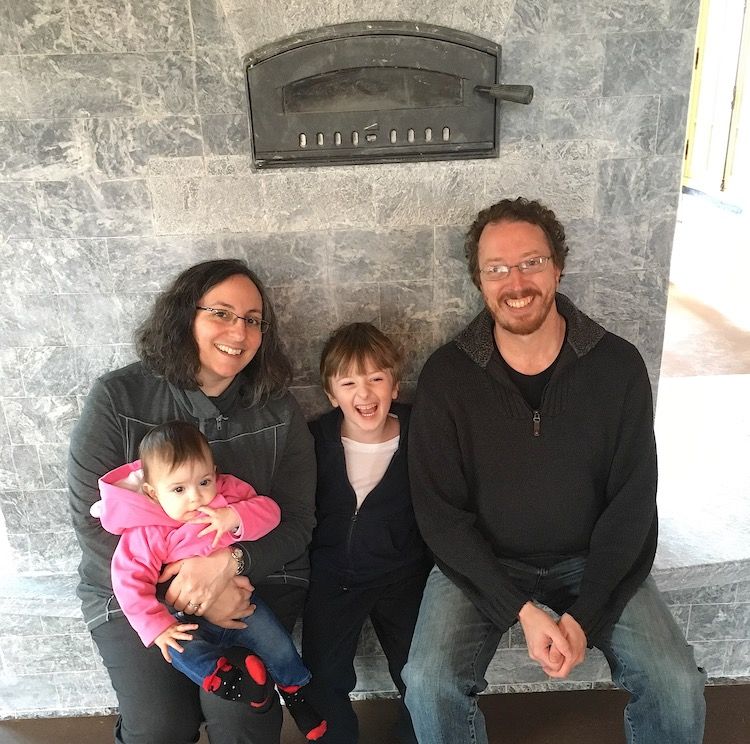
Build Well to Be Well is a collaborative venture between an architecture and construction firm located in Ottawa, Ontario, that uses ancient wisdom and natural materials to design and build buildings that are time tested, free from harmful chemicals, and built to enhance the human environment. We are currently completing projects in both Ontario and Quebec, as Ottawa and Gatineau are sister cities.
We are an architectural team founded by Bobby Ilg and Elizabeth Saikali, whose home is featured in this article, Pallavi Swaranjali, an architect with an environmental understanding of traditional Vastu Shastra principles, and a construction team founded by Ulrich Neeser, our principal builder. Our buildings are tailor-made for people with environmental sensitivities or anyone who wants a healthy and sustainable living and working environment. They are designed and constructed using the 25 environmental principles of the Building Biology Institute, a “pathway to healthier homes and buildings” which focuses on natural materials, durability and the health of Mother Earth and all living beings.
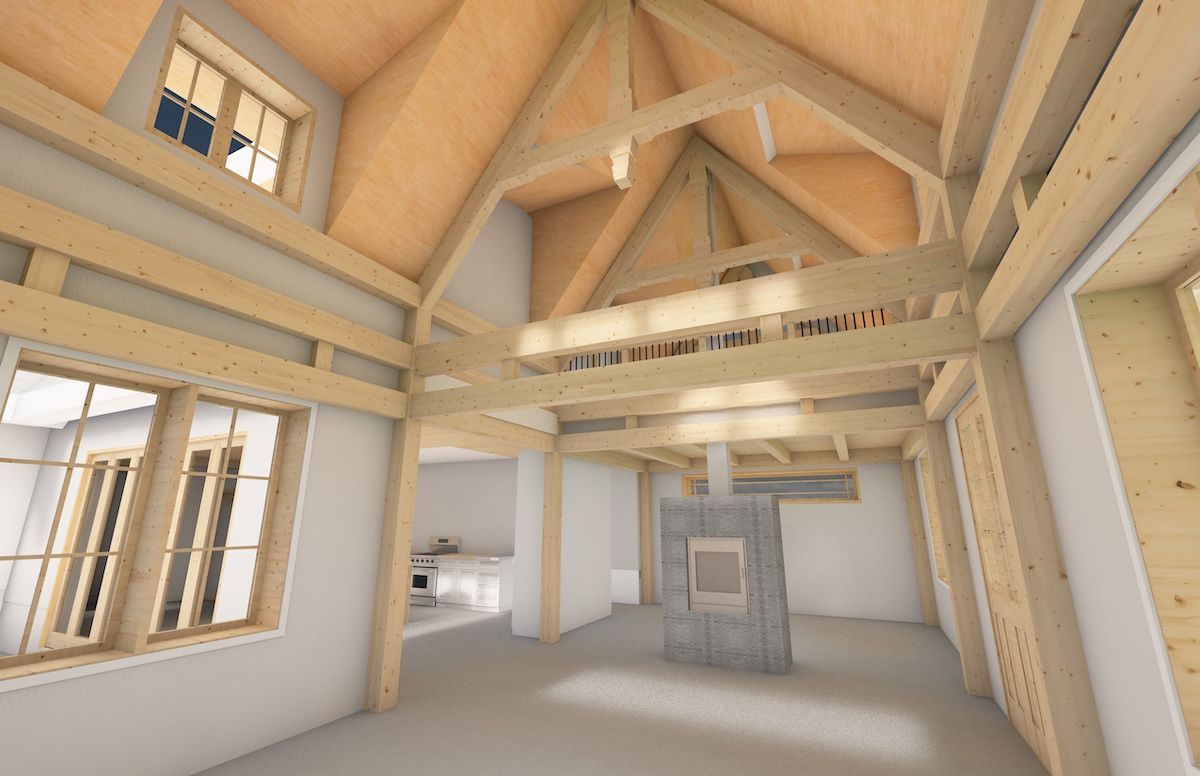
Until quite recently, humans always used local and unadulterated natural materials for the construction of buildings, materials that have a proven history of use for durability and longevity. For thousands of years multiple forms of earthen wall construction were used – and still are – around the world. There are two ancient wall systems, cob as well as wattle and daub, that use clay and straw as the primary ingredients. Cob construction is a monolithic clay and straw wall system, most commonly seen in the United Kingdom, Africa, the Middle East and eastern North America. Wattle and daub is a system of woven wood or bamboo with applied clay and straw fill, commonly found throughout Europe, Africa, Asia and North and South America. These are two ancient models that we use as the intellectual base for the clay and straw wall systems that we currently build with.

Following Nature’s principles, Build Well to Be Well strives to create health and wellness through the built environment. We do so by using healthy and natural building materials, passive design strategies and working with nature, rather than against it. Optimizing natural light and cross ventilation with the colours and materials of nature create timeless and beautiful spaces.
What is a healthy building?
A healthy building is constructed of natural materials and finishes, free of untested and harmful chemicals. It is designed with passive strategies focusing on natural light, fresh air, radiant heating, passive solar heating, natural ventilation and cooling, and interior ion balance. A healthy building is constructed for durability and longevity, using building techniques with a proven successful history of use, able to sustain several centuries of use with very little maintenance. It is designed to understand and respect water, allowing continuous vapor diffusion through mass walls thanks to natural hygroscopic building materials that balance interior humidity and moisture. Creating a healthy, natural and fully accessible building ensures that everyone can safely occupy that building, including those suffering from building-related sensitivities and illnesses.
According to Statistic Canada’s Canadian Community Health Survey, in 2016 almost 1 in 30 Canadians (more than 1 million people) suffered from building-related illnesses including Multiple Chemical Sensitivity (MCS) and Electromagnetic Hypersensitivity (EHS). Our primary goal is to design and construct buildings that support human health, making buildings accessible to all. This is where the Building Biology Institute and its blend of ancient and modern science and wisdom comes into the Build Well to Be Well building equation.

The Building Biology Institute offers courses and certifications for individuals interested in healthy and natural building practices. Its philosophy recognizes that ‘Nature is the Gold Standard’ for creating a healthy human environment and the ultimate model for perpetual ecological balance. It was developed in the 1970s by the German Institute of Building Biology + Sustainability and other baubiologie institutes were later established in many countries including the United States, in 1987. Professor of architecture, Anton Schneider and other Building Biology pioneers developed the 25 environmental building principles to help guide the building industry to create buildings that jointly nurture the health of the building occupants and the environment itself. It is the understanding that Mother Nature has given us everything we need to thrive, which includes unadulterated, non-toxic, natural building materials, and our ancestors provided the teachings of how to use them.
Several colleagues at Build Well to Be Well have taken their healthy building certification with the North American Building Biology Institute and are well versed in the natural and healthy building practices. Our growing team of designers and builders share the philosophy “build it once to last”; hence a natural building, if built correctly, will nurture its occupants for multiple lifetimes. As the principal architect at Build Well to Be Well, I continue to educate and advocate for a healthier building future. I am a part-time professor in the Bachelor of Interior Design program (BID) at Algonquin College, in Ottawa (Nepean), where I recently integrated a Building Biology certification into its BID curriculum. Education and awareness are critical to the understanding of creating a healthier and more natural built environment, and it starts with presenting an alternative ‘story’ to guide and follow by.
Ottawa's first EcoNest
Our journey began at an architecture conference in Montreal, Quebec, where I had the pleasure to attend a lecture by Paula Baker-Laporte on Building Biology and healthy, natural building practices. Paula suffered from building related chemical sensitivities and explained her journey of recovery and the wisdom she discovered along the way. The Building Biology principles and natural buildings were two important components for her healthy recovery, and has since allowed her to help guide others suffering from building related illnesses. After learning how many people suffer from building related illnesses and that there is a better way to build, we decided to transform our architecture firm and dedicate our professional careers to healthy and natural building practices. Two EcoNest workshops later, we decided it was time to venture into the natural building world and construct Ottawa’s first EcoNest home built of clay and straw construction.
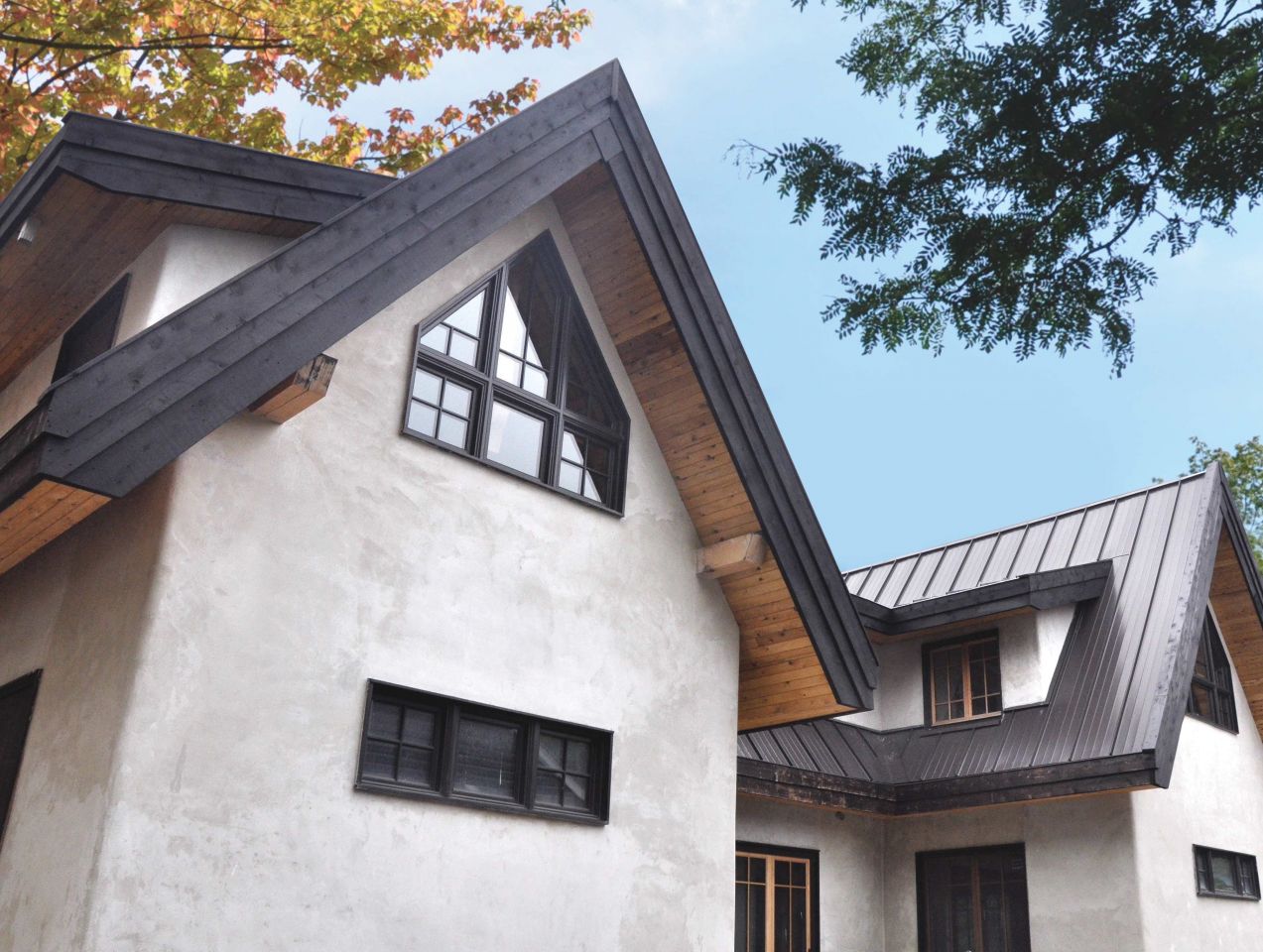
Built mainly in 2017, the Ilg/Saikali home featured here was the first clay and straw (also referred to as light straw-clay) construction approved by the City of Ottawa. Our family’s project broke down barriers from a natural building perspective and allowed for other clay and straw projects to commence in Ottawa. It all began with a student-oriented clay and straw building workshop held by EcoNest Homes, an Oregon-based natural building firm run by Architect Paula Baker-Laporte and husband Robert Laporte. For 30+ years, Robert has built EcoNest homes across North America, with timber frames, straw-clay walls, earthen plasters and natural, non-toxic finishes. Paula and Robert have left a significant ‘flock’ to continue this ancient tradition. Overall, the EcoNest student workshop initiated great interest for natural building in the Ottawa area. Even André Fauteux, the Editor of La Maison du 21e siècle magazine, had the pleasure of participating during the initial workshop, in October 2016.
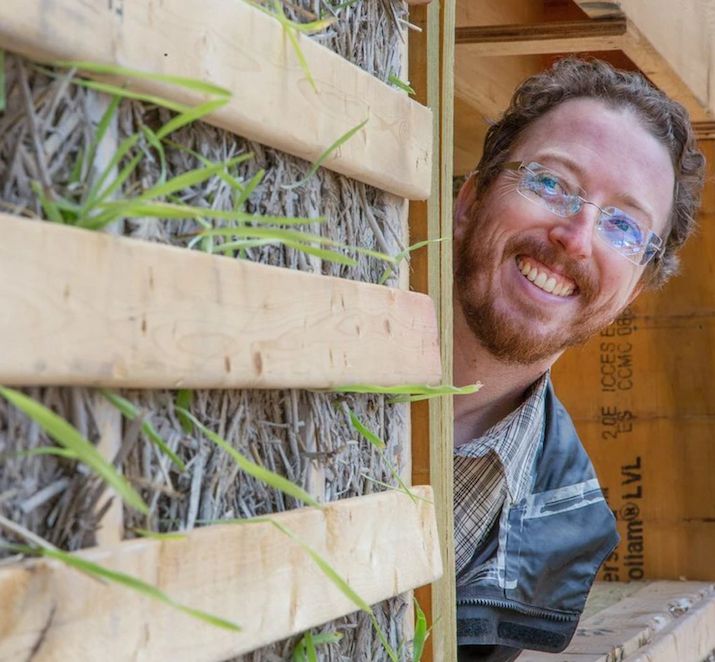
Walls that recognize water
During this workshop, Robert and I developed the first ever prefabricated clay and straw wall panel. This is a hybrid system of exterior and interior 2x4 wall panels infilled with clay and straw, and an interior core of 4.5” of three, 1.5 inch (R-4) highly permeable SONOclimat ECO4 wood fibreboard insulation panels. It is a local product manufactured by MLS, a company based in Louiseville, Quebec. The ECO4 board is comprised of wood sawdust bound together with a food-grade wax, and the three panels supply a continuous R-12 of insulation in the core of our clay and straw prefab panels. The total R-value of our completed walls is approximately R-24, which doesn’t account for the clay mass within the wall.
It would take a full book to describe all of the benefits of clay and straw walls, so I will just touch on a few here. Similar to any wet construction, our clay and straw walls require ample time to dry, and in Canada, we do not have long building season as it is. Hence we developed a method of assembling and drying panels in a controlled shop environment.
To provide an example, in a 4’ x 8’ wall panel filled with 3.5” of clay and straw, we combine approximately 200 gallons of water to powdered clay prior to mixing with loose straw. Once mixed, the clay-water “slip” binds itself to the molecular structure of the straw fill and wood framing during the critical drying process. This natural biological process allows the clay to protect against future moisture penetration. Fortunately, clay happens to love water and is always thirsty. When water moisture enters the mass clay and straw wall, the clay soaks up the water like a sponge, and keeps all the cellulose (straw and wood) in the wall dry. And much like a sponge, the clay will slowly release the moisture back again as it dries itself out, creating a reciprocal process.
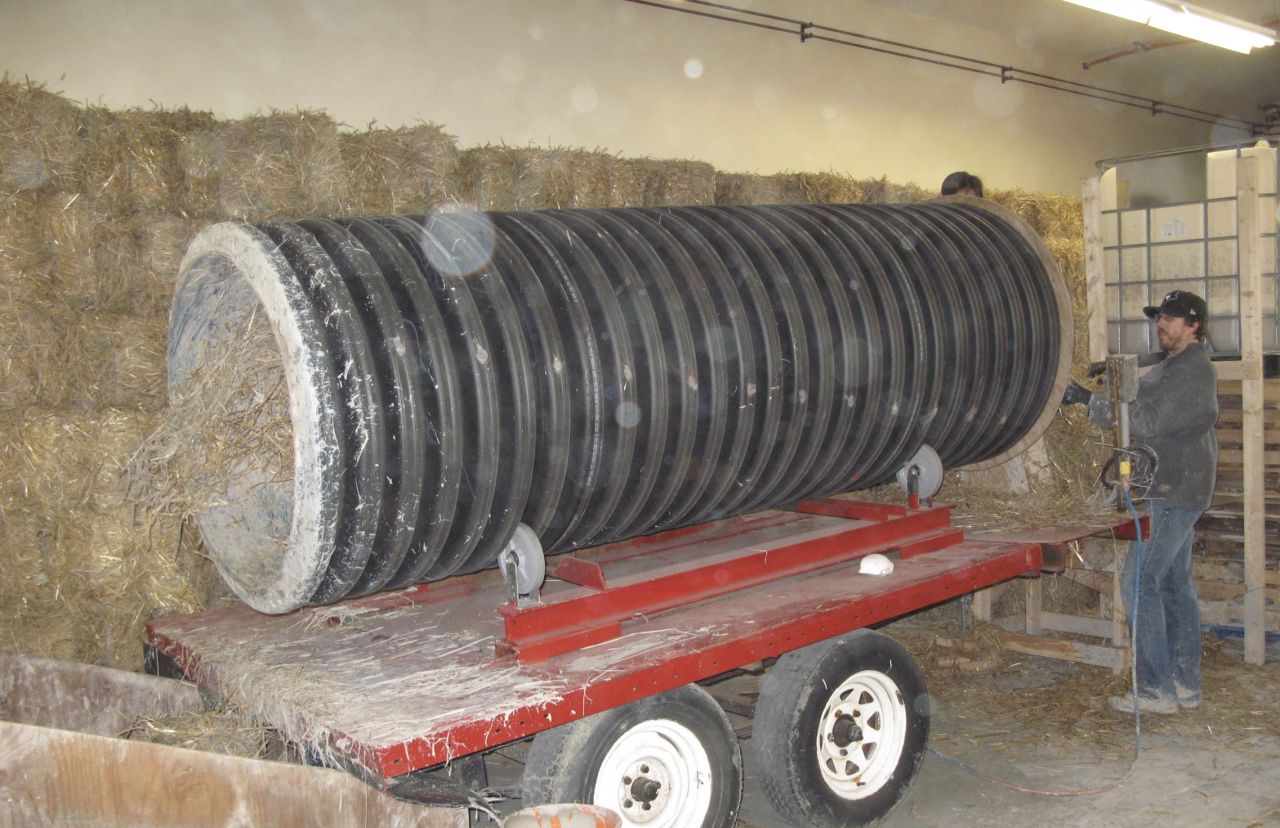
In fact, the clay and straw walls in our house could recognize approximately 40,000 gallons of water at any given time, and since it dried itself out once already during construction, it is able to do so again. Successfully drying out is key to the success of the clay and straw wall, and hence why all materials on the exterior walls must be highly permeable to freely allow moisture in and out of the wall assembly. Plywood, Oriented Strand Board (OSB) and plastic building materials tend to have a low permeability rate and to be more or less classified as vapour barriers that slow the drying process in case of condensation or water infiltration in walls. Vapour barriers cannot be used in mass walls of any sort, as they trap moisture which inevitably causes wall destruction. This respect and understanding of water is the primary reason clay and straw buildings tend to last for centuries.
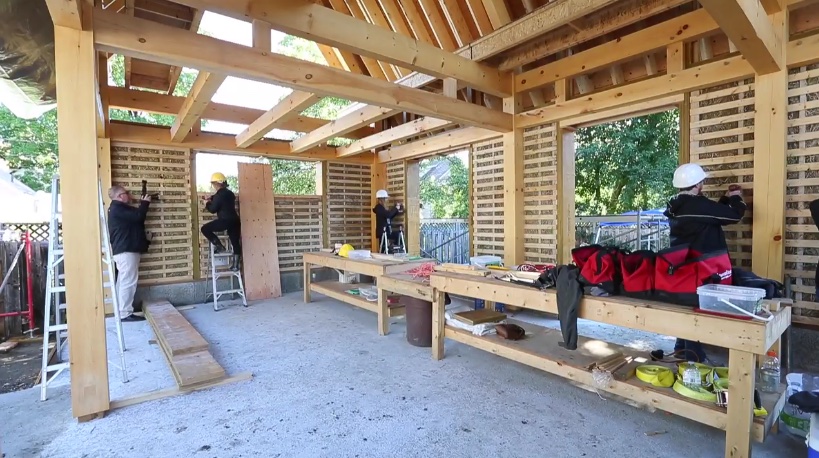
When the clay and straw wall panels arrive on the construction site, they have already been fully dried and are ready for plaster. We used a clay plaster finish on the interior of our walls for the hygric buffering capacity (ability to adsorb moisture) and a traditional lime plaster on the exterior, which is more durable to the weather. Both act as continuous air barriers and create a relatively air tight house from both the exterior and interior side of the wall assembly. The moisture control of interior clay plaster is quite remarkable as it will retain moisture during high periods of interior humidity, creating a stable relative humidity inside the building. When we take a shower in our washroom, our mirror never fogs up, as the clay plaster adsorbs the excess moisture in the air and then releases it slowly as the relative humidity lowers. Apart from adsorbing water and vapor, the interior clay mass inside the home is also the primary way to capture and store passive solar heat. The heat from the sun may warm the interior spaces while it is shining through the windows, but some form of mass has to store this warmth and release it later, so the energy from the sun can continue heating after the sun takes a rest for the night.

To further understand passive solar heat, radiant heating is an essential Building Biology principle that requires a little explanation for those of us accustomed to forced air heating in North America. In simple terms, radiant heat is the transfer of heat through the infrared frequencies of the electromagnetic spectrum. Similar to the sun, the transfer of radiant heat occurs between two masses, and the heat moves from the hot mass to the cooler mass. Humans are largely made of mass (97 % carbon and water) and also act as sources of radiant heat; however the sun, being much hotter than we are, transfers its heat to us. Think about standing outside, it is always much warmer in sunlight than in the shade. This is due to the sun using all of its energy to heat us, the mass, and not the air around us which is only heated indirectly by its contact with hotter masses. This is very important to understand when discussing the true efficiency and comfort of radiant heat.
We have radiant floors installed on both floors of our house (to meet building code requirements) and have also installed a wood burning soapstone masonry heater. A masonry heater is modelled on medieval technology exploring large fire-burning cavities, covered in stone, plaster and tile, resulting in a mass heater that produces gentle heat while efficiently burning the majority of the gases generated from burning wood. With one fire burn each day in the masonry heater, we heat majority of our 2,500-square-foot house, and rarely use our radiant floors. For healthy ventilation, we sleep with our windows open even in the winter months because with radiant heat keeping us warm, the air temperature is irrelevant to our comfort. Where radiant floors primarily heat our feet, a masonry heater warms every part of us from head to toe, including on the second floor of our house, which is open to the heater through a cathedral ceiling. The masonry heater was worth every investment as it truly is the heart of the house.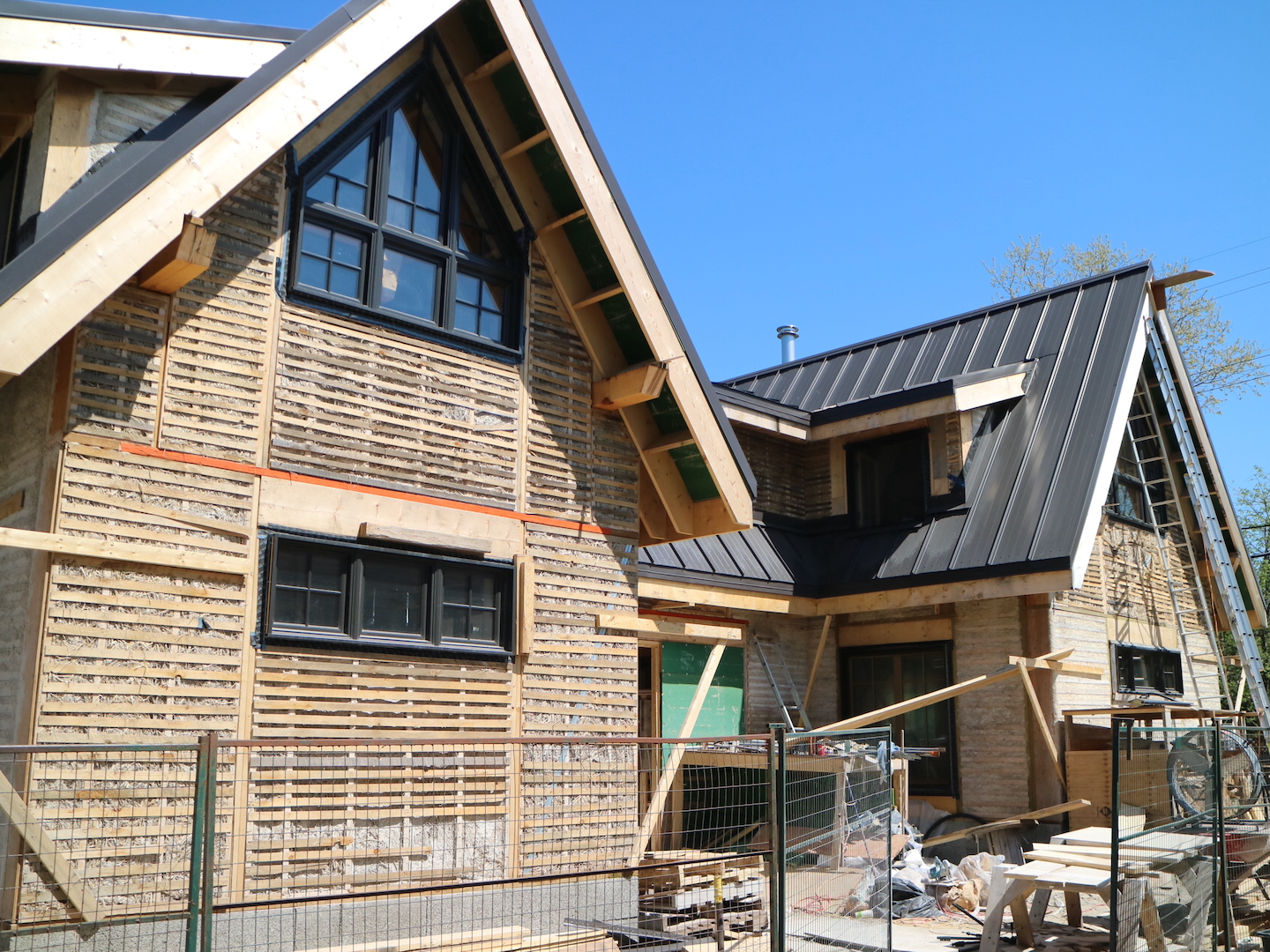
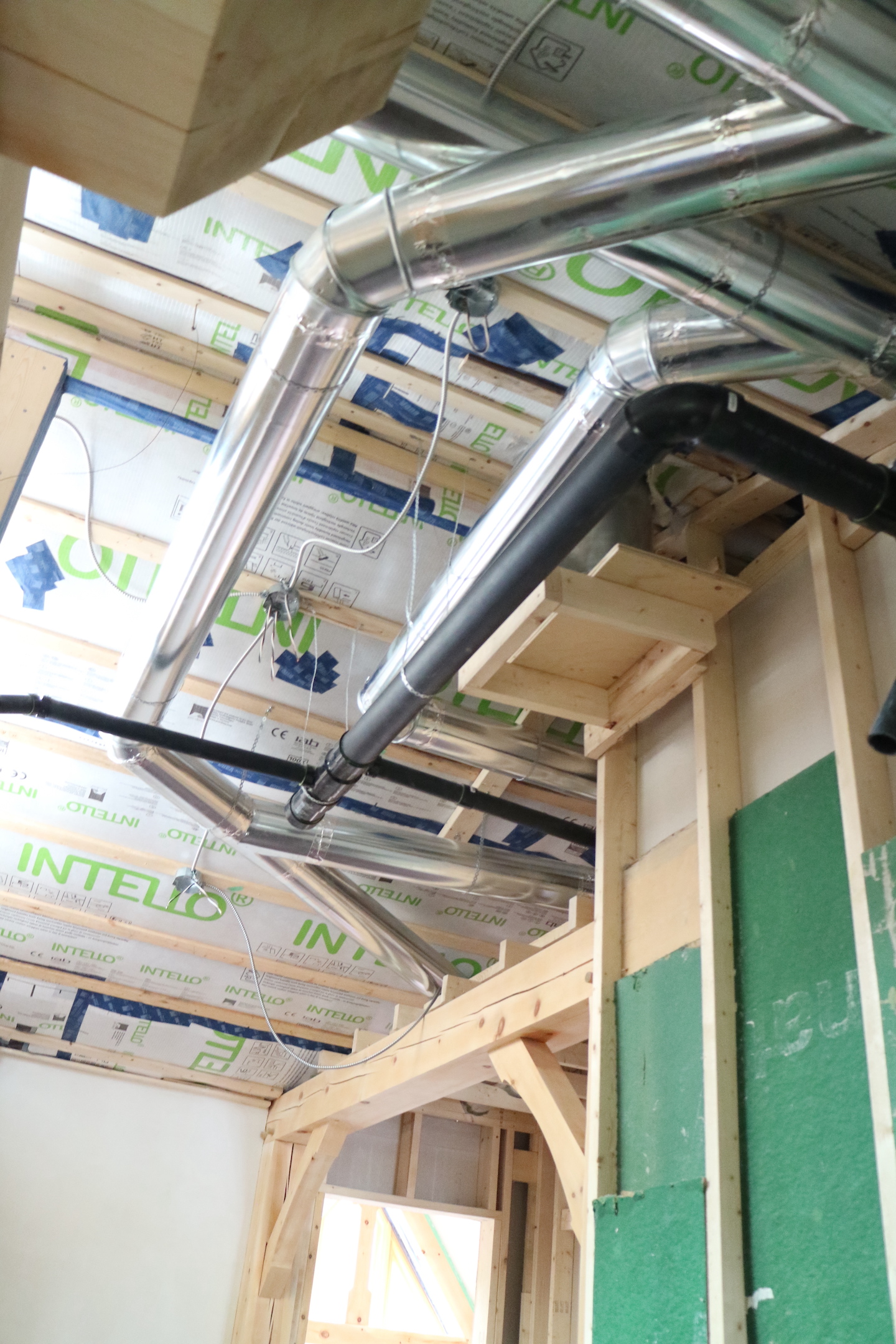
Another extremely important Building Biology principle related to health is fresh air. Mechanical systems have dictated the way we heat, cool and unfortunately ventilate buildings. From the Building Biology perspective, a truly healthy environment requires ample natural ventilation through multiple windows and other intentional openings, because the fresh air coming through a window is much different than the air travelling through a system of metal or plastic ducts before finally entering a room. Please note, that this fresh air should not be mistaken with a ‘drafty’ building envelope, as it is very important to have an air tight building envelope, so you can control when and where the fresh air enters the building. For Building Biologists, mechanical ventilation ducts are perceived as life support that should only be used when absolutely necessary. From a heating and cooling perspective, thermal mass and radiant heating debunk the mechanical myth that one must keep windows shut. Massive floors, walls and ceilings help maintain a stable interior environment by storing heat in winter and the coolness of nighttime air in the summer. With thermal mass and radiant heating, there is no need to preheat fresh air to ensure comfort and health. We were required to install a Heat Recovery Ventilator (HRV) in our house, and we initially used it the first year that we lived in it. However, from our own experience, the fresh air just wasn’t the same through an HRV compared to living with our windows open year-round, so we have decided to completely turn off our HRV system. I don’t think I could ever return to a mechanically-ventilated building, including an office, which is equally just as important. The clay and straw wall after assembly and prior to receiving the lime plaster exterior.
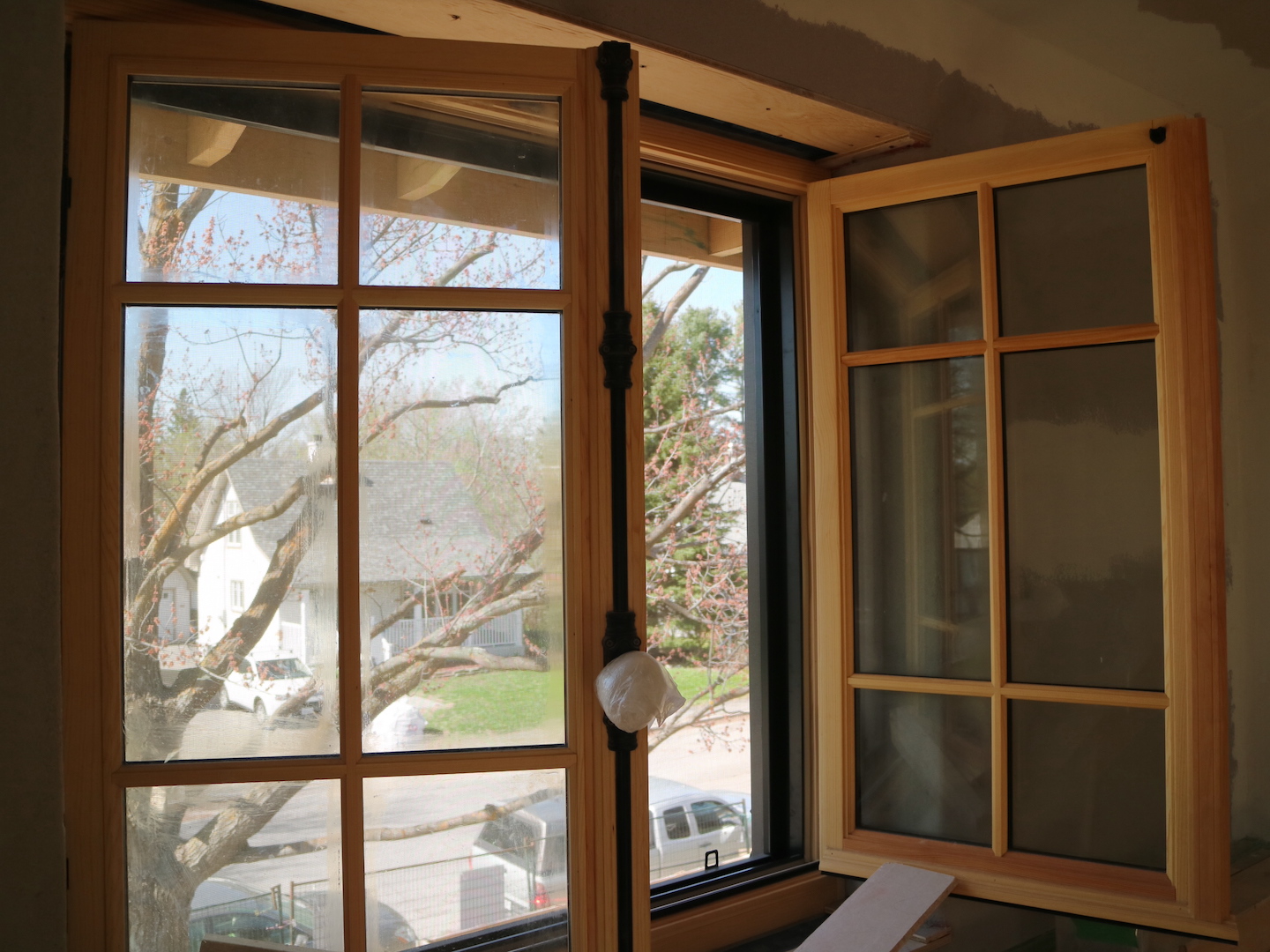
Since completing our house, we have multiple clay and straw projects currently in construction in the Ottawa and Gatineau area. From Tully’s Way Farm in Perth, Ontario, to urban residential projects in Ottawa, we are creating healthy, natural spaces for various clientele with the common interest in supporting the environment. We are currently in the design phase for a project in Wakefield, Québec, scheduled for construction in 2022. The clients discovered us through our interviews with André Fauteux’s available on La Maison du 21e siècle magazine’s Youtube Channel. The Wakefield clay and straw house will be part of the owner’s larger vision incorporating a permaculture haven demonstrating the beauty of natural relationships. We look forward to presenting and celebrating it in a future issue of the magazine.
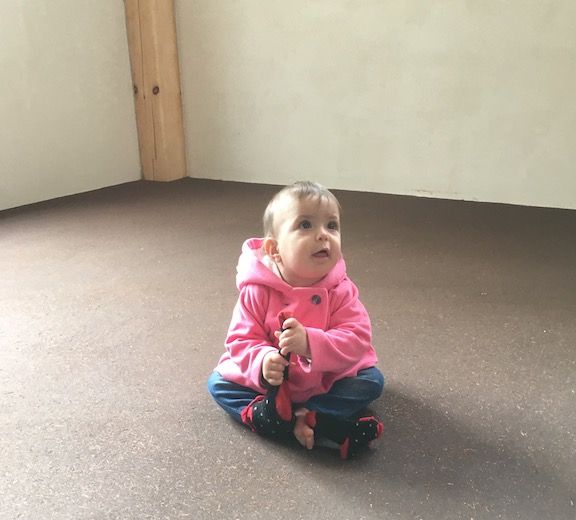
In summary, our Ottawa EcoNest respects the Building Biology principles focusing on the natural beauty that only Mother Nature possesses. From the richness of the interior clay plaster to the subtle complexity of the earthen floor, the use of natural materials ensures the beauty of the outside world enters through the front door and is predominant throughout our home. From the radiant winter warmth of the energy-efficient soapstone masonry heater to the cool summer evening breezes, sunlight illuminates while fresh air fills the space from one wood window to another. From the burnt splendour of our self-crafted Shou Sugi Ban kitchen wall to the structural rhythm of the white pine frame, carbon is permanently sequestered in the building, creating a negative carbon footprint for the duration of our home. Traditional exterior lime plaster, with its impressive nine thousand year history, coats the outside of the clay and straw walls, combining the ultimate air barrier with timeless beauty. And to ensure all authenticity, there is as much cow manure as lime in these plastered walls. Replacing the chemical compounds of cement with the durability and flexibility that only manure understands is a natural plastering wonder for our Northern climate’s freeze-thaw cycles. A natural building is truly meant for longevity and stunning beauty, as much as nurturing the health of the generations to live within it.

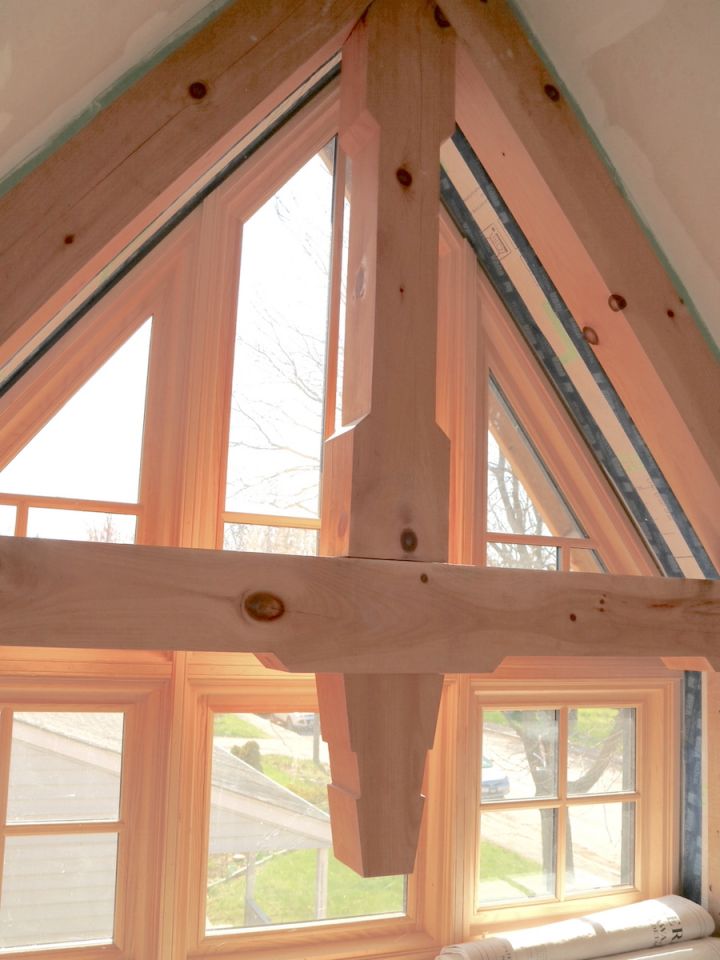
As all natural building projects initiate collaborations and lasting relationships, Build Well to Be Well would like to offer a special thanks to the people who helped this natural house become a reality. Paula Baker-Laporte and Robert Laporte of EcoNest, you continue to inspire us to teach your ancient, healthy and durable building methods. You will always be mentors to us. Builder Kris Bailey and his team at Perth-based Dwellings Design-Build brought the timber frame to life and continues to evolve the straw-clay panel production with BuildWise, our natural prefab company. Sonia Martin of Quebec-based Martin Windows who supplied local and truly beautiful wood windows crafted from three generations of family tradition. John and Michael Sinclair of Sage Restoration in Kingston taught us the magical art of using natural finishes for natural materials, in particular pine tar, linseed oil and beeswax. Deirdre McGahern of Straworks of Peterborough crafted our beautiful and inimitable earthen floors. And a final gratitude to all natural builders from the Ontario Natural Building Coalition, who constantly collaborate and support each other, developing the natural building communities that we continue to grow together.
+
buildhealthy.ca
naturalbuildingcoalition.ca
Videos of the 2016 EcoNest workshop : https://bit.ly/2X4ZAj1



